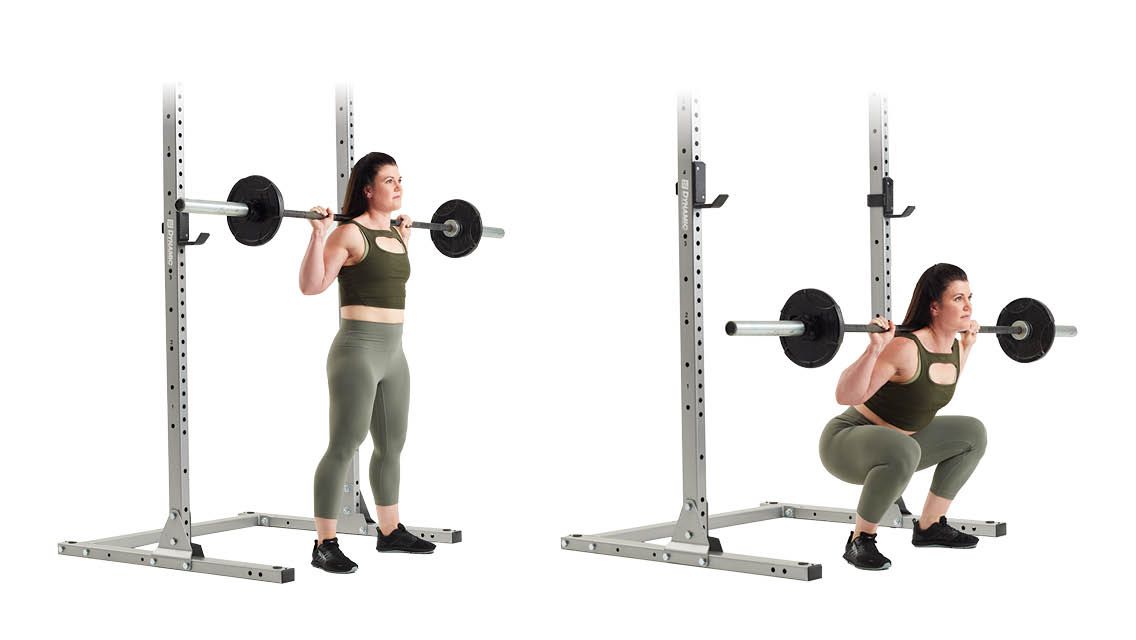Barbell Squats: The Ultimate Lower Body Exercise
The biomechanics, safety, progressive overload, and key coaching points of the classic barbell squat.

Biomechanics, safety, progressive overload, and key coaching points.
Squatting is a fundamental human movement pattern that has been used for centuries for various purposes such as lifting heavy loads, working on farms, and performing daily tasks [1]. The barbell squat is a highly effective exercise that activates and engages the muscles of the lower body [2]. The barbell squat requires significant posterior chain engagement as well as abdominal activation [2].
In this blog post, we will discuss the biomechanics of squatting, safety aspects, how to implement progressive overload, and key coaching points for PTs/AES/AEPs/fitness trainers.
Squats are a compound movement.
Muscles used: Quadriceps, Hamstrings, Glutes, Erector Spinae, Abdominals
Biomechanics of Squatting
The barbell squat is a complex movement that involves the coordination of multiple joints and muscle groups [2]. When squatting, the ankle, knee, and hip joints must work together to control the descent and ascent of the barbell. The quadriceps, hamstrings, and glutes are the primary muscle groups responsible for the movement, with abdominal "core" muscles and other posterior chain muscles [3] playing important roles in maintaining stability and balance.
During the squat, the ankle joint dorsiflexes, allowing the knee to move forward and descend towards the ground. The hip joint also flexes, allowing the body to lower towards the ground.
At the bottom of the squat, the knees should be positioned directly above the feet, and the hips should be just below parallel to the ground. The greatest load on the body is also at the bottom of the squat, when the thighs are parallel to the ground. Because of this high load, the individual squatting will feel that the bottom of the squat is the "hardest" part of the exercise. This is often where injury occurs, if the weight is too high [4].
The descent should be controlled, with the focus on maintaining a neutral spine and good posture. Typically, individuals utilise the Valsalva movement (increasing intra-abdominal pressure by breathwork) for greater stability.
When rising from the squat, the ankle joint plantarflexes, pushing the foot into the ground and extending the knee. The hip joint also extends, pushing the body back to an upright position. Throughout the movement, it is important to keep the barbell positioned over the midfoot, maintain a neutral spine, and engage the core to maintain stability.
Safety Aspects and Considerations
The barbell squat is a demanding exercise that requires proper form and technique to avoid injury. Improper form, such as excessive forward lean, rounded lower back, or hyperextension of the knee, can put unnecessary stress on the joints and increase the risk of injury. The most common way injury occurs is when the weight is too heavy and the individual is unable to ascend.
It is important to always use proper equipment, such as a squat rack, safety guards, barbell collars, and to warm up thoroughly before performing squats. Proper progression is also important in avoiding injury. Start with a light weight (even just the barbell) and gradually increase the weight as form and technique improve.
It is also important to listen to your body and avoid lifting weights that cause pain or discomfort.

Eliciting Progressive Overload
Progressive overload is the gradual increase of stress placed on the muscles and body over time. This is essential for continued progress and improvement in strength and muscle size.
In the barbell squat, progressive overload can be achieved by gradually increasing the weight lifted, performing more reps, or reducing rest time between sets.
To ensure continued progress, it is important to regularly assess form and technique and make adjustments as needed.
There is also merit to varying your exercise routine regarding squats to attempt to progressively overload and prevent boredom. Performing squats with different foot positions, with wide or narrow stance, and incorporating variations such a front squats and pistol squats is important. However, too much variability can send your progress backwards. It's recommended to program one type of squat with accessory squats for at least 4 weeks to elicit progression.
Key Coaching Points
For trainers, coaches, and clinical exercise professionals
Key Coaching Points
- Stance: Feet should be hip-width apart with the toes pointing slightly outward.
- Bar placement: The barbell should be positioned on the traps or on the upper back with a low bar position.
- Core engagement: Brace the core and maintain a neutral spine throughout the movement.
- Descent: Lower the body by bending at the hips and knees, keeping the weight over the midfoot and maintaining a neutral spine. The knees should track over the toes, and the hips should lower just below parallel to the ground.
- Ascent: Push through the midfoot to extend the hips and knees, rising back to an upright position.
- Balance: Keep the barbell positioned over the midfoot and engage the core and lats to maintain stability and balance.
- Range of motion: Ensure that the hips are just below parallel to the ground at the bottom of the squat, and that the knees do not hyperextend at the top of the squat.
- Breathing: Exhale on the ascent and inhale on the descent.
It is important to emphasize proper form and technique to avoid injury and maximize the benefits of the exercise. Gradual progression and regular assessment of form and technique are also crucial for continued progress.
Regenerate response

References
[1] Chan, C. H. S., Ha, A. S. C., Lander, N., & Ng, J. Y. Y. (2022). Understanding the teaching and learning of fundamental movement skills in the primary physical education setting: A qualitative study, Journal of Teaching in Physical Education. doi: 10.1123/jtpe.2021-0206
[2] Delgado, J., Drinkwater, E. J., Banyard, H. G., Haff, G. G., & Nosaka, K. (2019). Comparison between back squat, romanian deadlift, and barbell hip thrust for leg and hip muscle activities during hip extension, The Journal of Strength and Conditioning Research, 33(10), 2595-2601. doi: 10.1519/JSC.0000000000003290
[3] Tataryn, N., Simas, V., Catterall, T., Furness, J., & Keogh, J. W. L. (2021). Posterior-chain resistance training compared to general exercise and walking programmes for the treatment of chronic low back pain in the general population: A systematic review and meta-analysis, Sports Medicine-Open, 7, 17. doi: 10.1186/s40798-021-00306-w
[4] Lorenzetti, S., Ostermann, M., Zielder, F., Zimmer, P., Jentsch, L., List, R., Taylor, W. R., & Schellenberg, F. (2018). How to squat? Effects of various stance widths, foot placement angles and level of experience on knee, hip and trunk motion and loading, BMC Sports Science, Medicine and Rehabilitation 10(14), doi: 10.1186/s13102-018-0103-7

